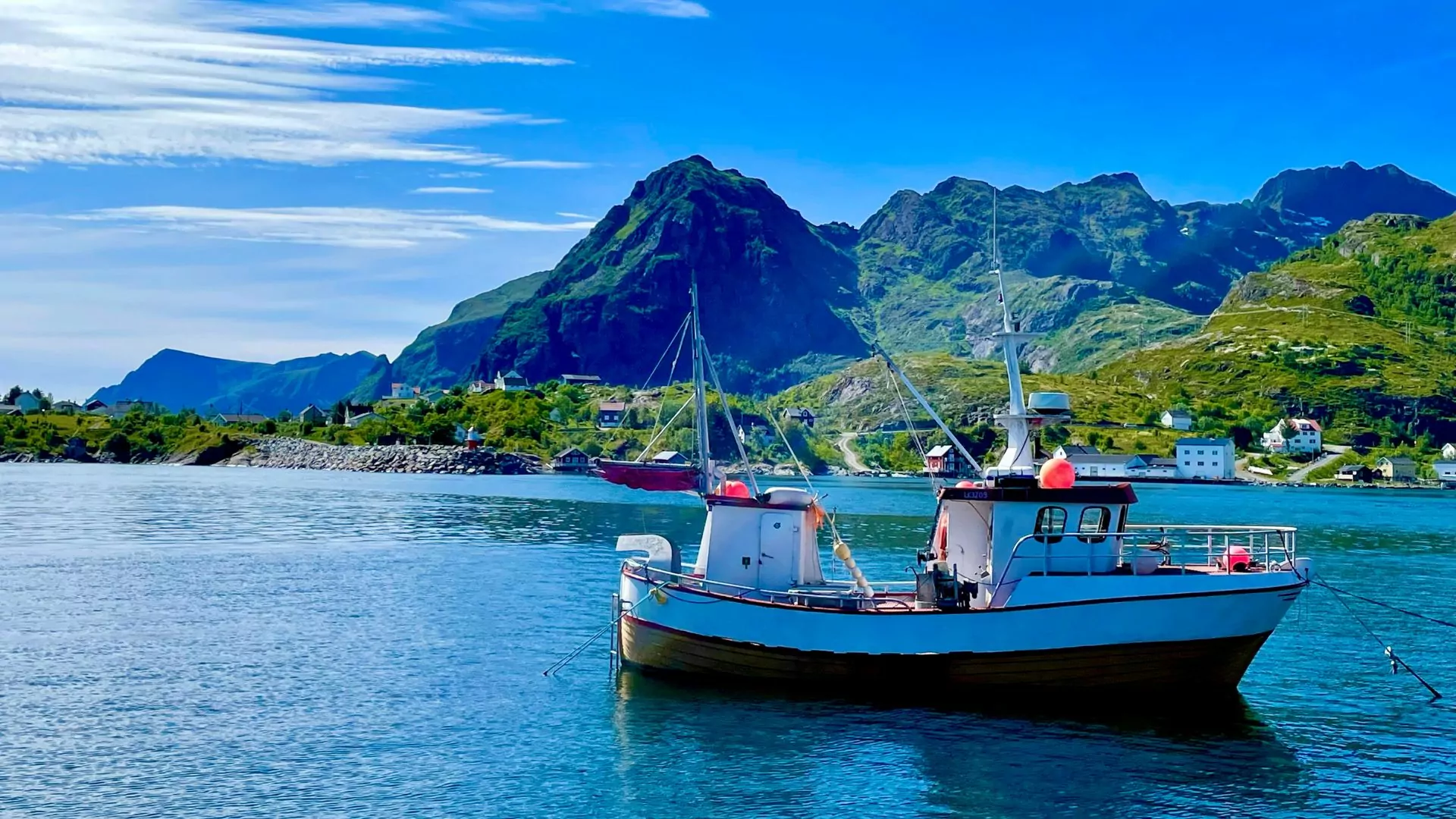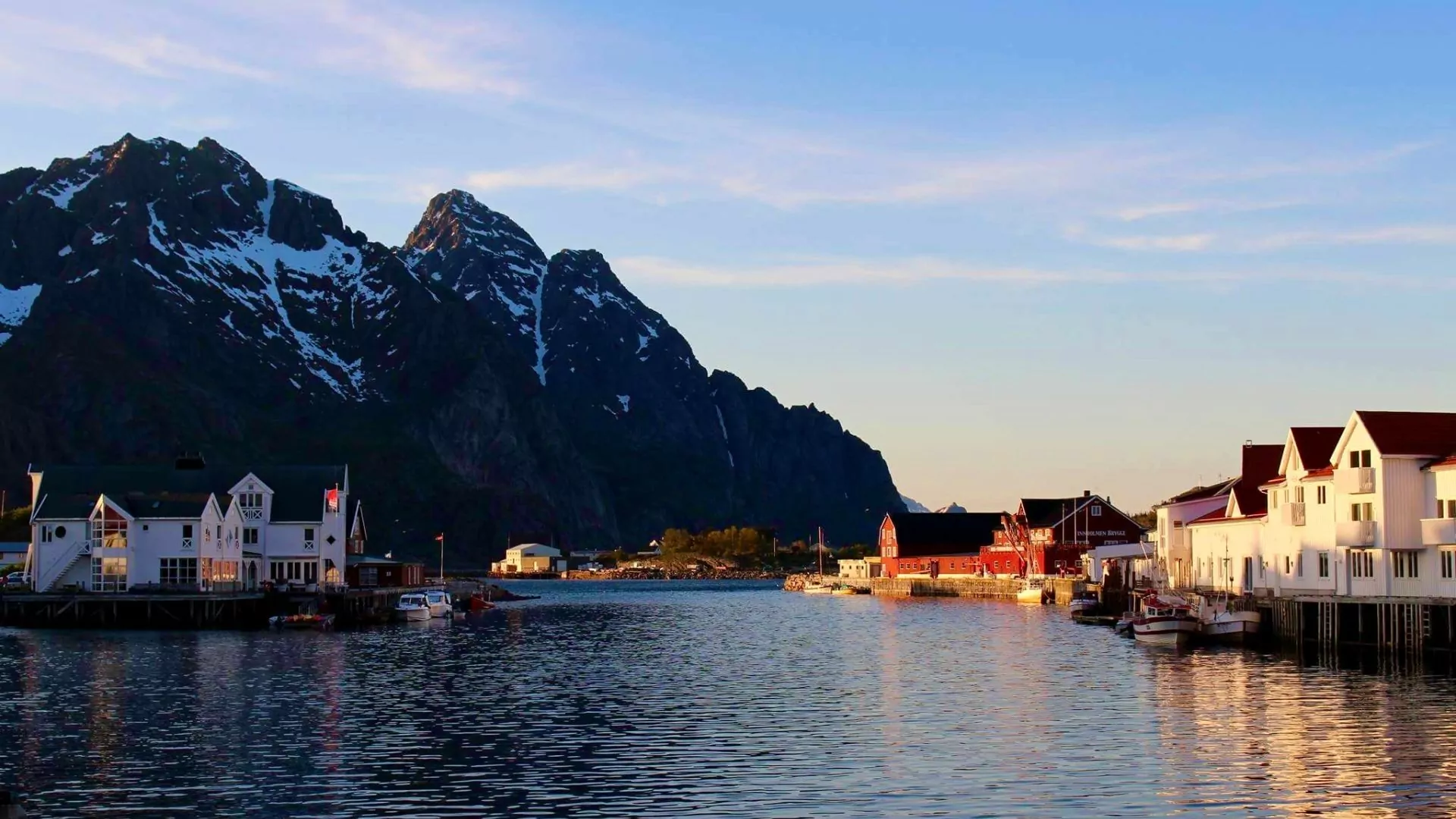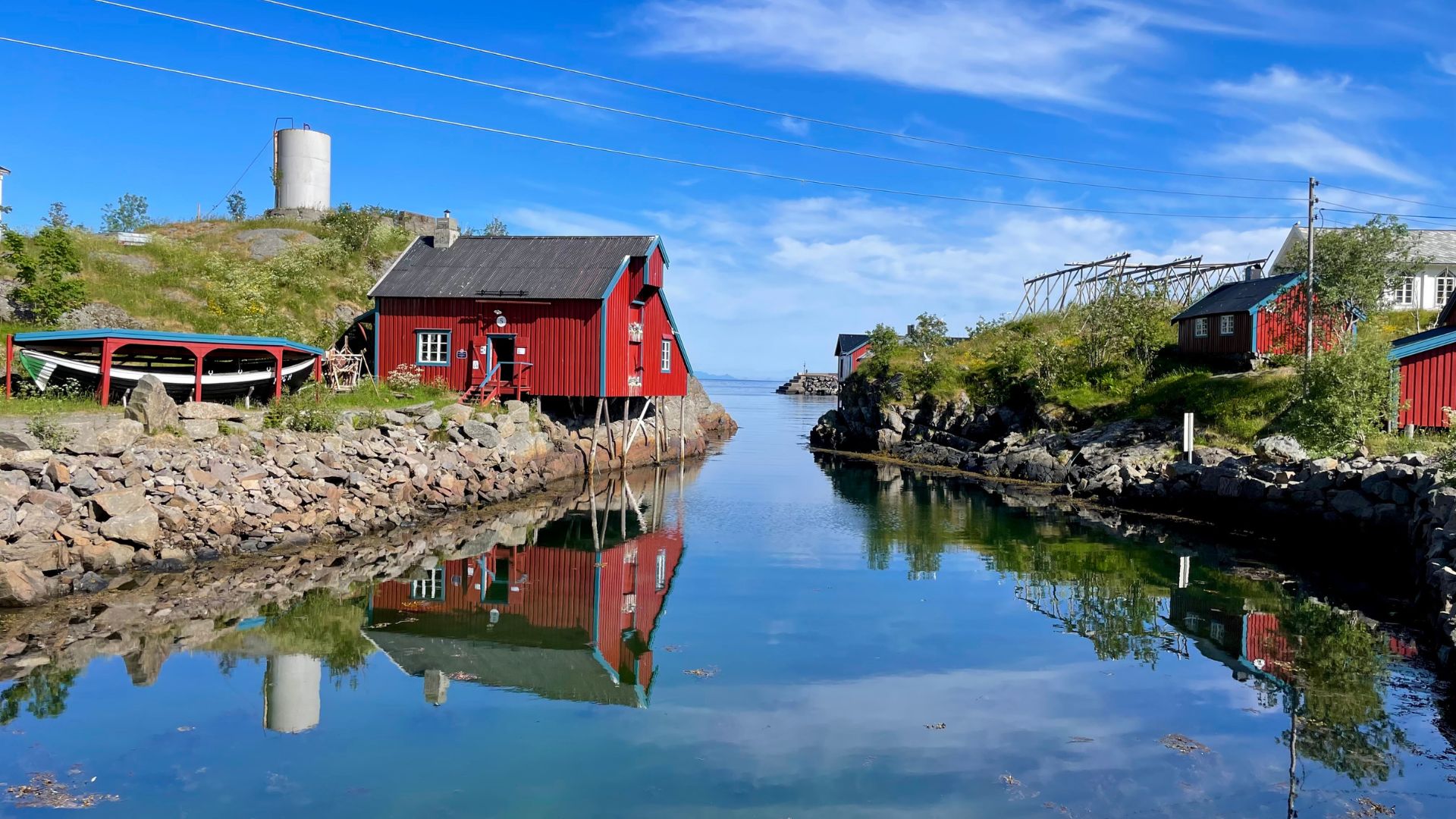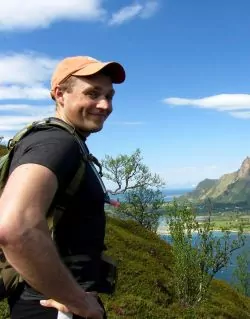Norway’s Lofoten Islands
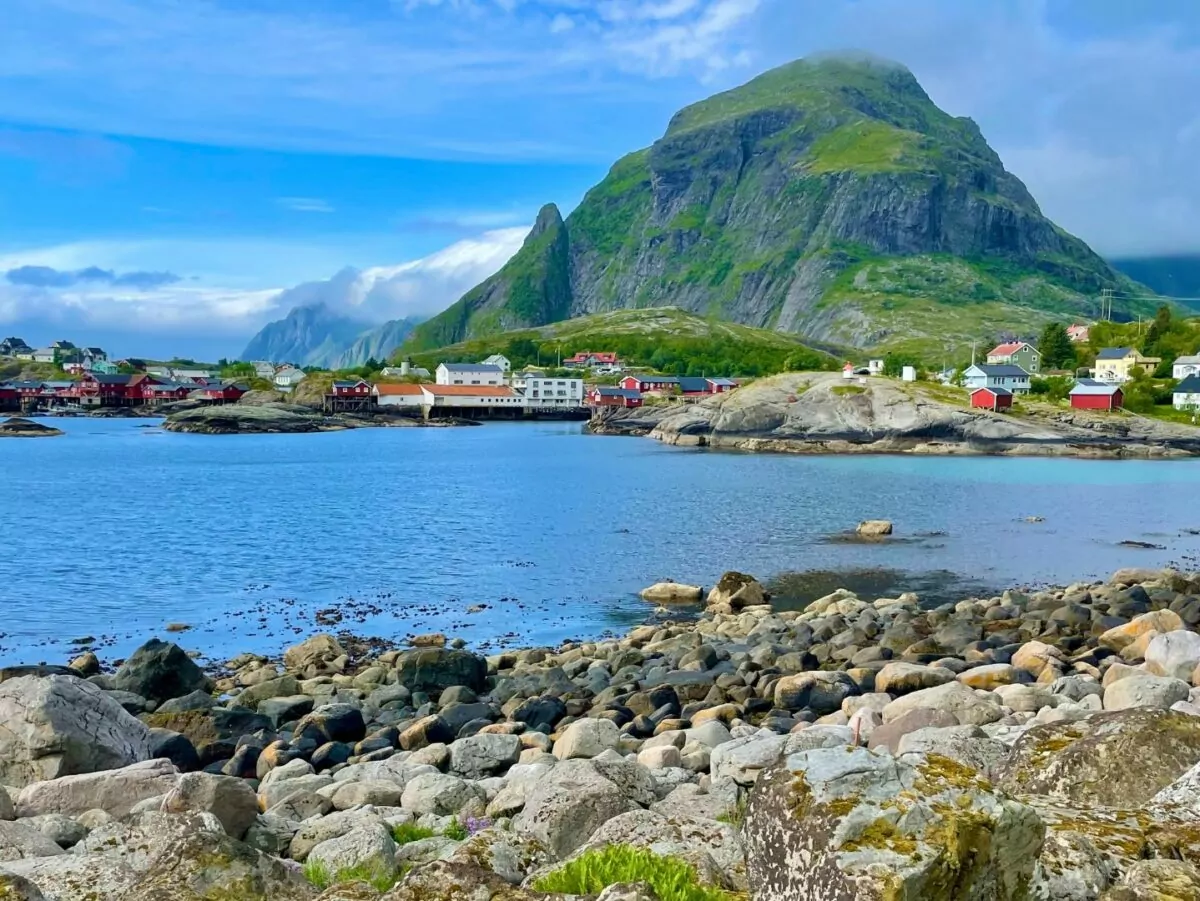
This story is an excerpt from Dan Purdy’s recent book The Nomadic Notebook – Norway. After taking a leave of absence from his career as an aerospace engineer, Dan volunteered at a remote island lodge in Nordskot, Norway. Once there, he joined forces with his host – the powerfully built Jesper – as they worked to grow the fledgling lodge business. But partway through this experience, Dan had the opportunity to visit one of Norway’s most beautiful regions, the Lofoten Islands…
A Brief Encounter - Lofoten
Our cabin’s front door faced the daunting mountainous archipelago: the Lofoten Islands. It quickly became part of my morning routine to stop and marvel before starting the day. I often imagined Homer’s poem The Odyssey coming to life with Odysseus sailing off into those mists to narrowly avoid falling prey to sirens. No matter how bleary-eyed I started the day as I rushed to the main kitchen to get Astrid’s bread in the oven and lay out breakfast for the guests, there was something resolute about that first view. Timeless and absolute, they were a steadfast marker to orient my mind, and I repeatedly promised myself a visit there.
Luck contrived in my favor in the form of two visiting couples from eastern Europe who booked a RIB (Rigid Inflatable Boat) journey to those distant islands. With just four seats left on a boat that held twenty, Jesper wouldn’t let the opportunity to show us one of Norway’s more beautiful locations pass by.
Our preparations for an overpowered speedboat trip to Lofoten continued as layers upon layers of waterproof gear flowed out of the boat’s forward hatch, followed by neon yellow life preservers.
Our captain carefully handed these items to every passenger, “If you go in the water with no protection, you have only six minutes.”
The last items passed around were clear safety glasses – an accessory I’d never thought I’d be required to wear on a boat trip. Our captain explained it succinctly enough, “we go very fast,” he stated while pointing to the distant spine of mountains “If very fast salt water hit your eye, it hurts.”
I briefly thought about how a speeding drop of icy salt water slamming into my eyeball at sixty miles per hour would feel. I blinked away the perceived pain and quickly slipped on my safety glasses. My imagination of Odysseus crossing an unknown sea was sufficient without a poor imitation of the Cyclops joining the adventure.
Those thirty miles seemed to melt away ahead of the mighty roar of the overpowered RIB boat. Every glance back toward the mountains seemed to bring them noticeably closer. Each seemed dark and foreboding, like the weathered Jötnar giants of Norse mythology with their icy, snow-bound heads. Each spectacularly sharp peak, chiseled shoulder, and vast cliff plunging straight into the sea gave this ice-carved land a character of its own.
I marveled and imagined how any town or city could find space to coexist with these broad giants. Even at that rapidly diminishing distance, every scrap of rocky land seemed part of an impossibly steep mountain. And yet, I was told that a string of villages existed here, and we were heading to one called Henningsvær.
Visit The Lofoten Islands WITH WILDLAND TREKKING
One of the dark shapes in front of the mountains slowly took shape as the famous Hurtigruten ferry and our captain’s focused face split into a wide grin. I noticed him shift his weight and lean noticeably to his right, and I only had time to briefly wonder if the view was really much better over there before he violently spun the wheel. Momentum almost flung the rest of us from our seats as we desperately grabbed handrails and each other to keep from careening off into the ocean. We seemed suspended over oblivion for a split second as the boat lurched through its hard-right turn.
We had cut towards the massive, lumbering ferry. I heard a sharp hoot of joy as the captain pushed the throttle to the stop and aimed for the ferry’s rolling wake, mixed with a sharp scream of terror from the front of the boat as one of our guests realized what was about to happen. We only had time to clutch our metal-framed seats before the boat catapulted over the wave and became entirely airborne momentarily. One of the men up front raised his hands like he was on a rollercoaster before we crashed back into the ocean, jolting us all once more. Our white knuckles slowly relaxed as the captain eased the throttles and lazily steered us to a collection of buildings that materialized from behind the ferry’s plump shape.
I was captivated by the village that opened up before us. Packed onto small strips of land sitting delicately in the shadow of one of Lofoten’s prominent mountains, the robustly squat buildings seemed to be clinging to whatever flat land they could find. But as I quickly learned, flat land always ran short in Lofoten. Here in Henningsvær, generations of hardy locals had turned a waterway between two long spits of land into their main thoroughfare with sturdy wooden and concrete docks lining its entire length to make room for even more buildings cantilevered over the Norwegian Sea.
But what grabbed my attention most was the warm color. Striking red and dijon yellow facades dappled those streets. Bright signs called out fersk fisk and varm mat as vibrant cafes touted their deliciously fresh fish and hot meals in stout defiance of the bitter sea and unforgiving mountains that flanked them on all sides.
One such café caught our attention with a broad wooden deck protruding over the turquoise water. Without the typical scattered clouds, the water shimmered brilliantly in the uninterrupted sun as it delicately splashed on the soft, algae-covered, rocks below. But the true draw for our little group was the massive bowl of fish stew and fresh bread that had just been served to another patron seated on the deck. The blustery and chilly speedboat crossing still showed brightly on our flushed cheeks, and we didn’t bother wasting breath on words as we agreed that this establishment was for us. Just a few minutes later, we were also seated on the deck with our own bowls of stew and what seemed like an entire loaf of bread divided among our plates.
Between soul-warming bites of buttery cod and potato soup, I took the opportunity to admire this remarkable village. Our deck was perched above the main waterway bisecting the town, and we watched the steady march of local fishermen, vacation boats, and larger tourist charters filter through this ocean boulevard.
I’d never seen a place so intimately connected to the sea before. While there was one solitary road leap-frogging from the mainland across not one but two small islands via an intricate bridge network, it was clear that the sea was this area’s true connection to the world. What little rocky shoreline that wasn’t occupied with a building hosted a series of matchstick-like structures that I soon learned were old-fashioned fish drying racks. While most of them were simply for aesthetics to highlight the area’s fishing history – as I learned from Jesper – the constant screech of gulls near a few of the racks was clear evidence that at least a few were still in use.
However, I was still just as entranced by the mountains here as I was thirty miles away on our front porch back home. Their sharp peaks surged thousands of feet into the air while rocky cliffs plunged straight into the ocean to form the bedrock that held this fantastical place together. Looking to the right and left, the mountains unfolded all the way to the horizon, an endless maze of rugged beauty. Behind us, the closest mountains seemed built on layers, each competing for the best position by shoving each other aside and thrusting their competitive peaks higher and higher to see which one would win – creating a mosaic of mountains where I could just barely make out a distant hiking trail disappearing into its intricate design.
With this mountainous backdrop, the village seemed to be a living entity comfortably hunkered into what seemed like one of the most beautifully harsh places in the world. After our hearty fish stew, friendly lights beckoned up and down the streets as we explored, waving us into every shop or market like a well-meaning local. Meanwhile, the steady water lazily wafting through that center canal made the village appear to be breathing deep, tranquil sighs. The fulfilling exhales of one who was content, and that was simply enough.
Our allotted afternoon there expired too soon with a shrill whistle from our captain about fifty yards up the main channel at the public dock. But as we made that last walk through the stone-flagged streets, I smiled back at the friendly world that had allowed me to visit. I left that village with the same emotions as I would leave a dear friend. A friendship that I’ve rekindled in the years since that first trip, and forever grateful for the resonating connection that a fleeting visit created.
If Dan’s adventures in Norway spark your imagination and interest, consider reading his full book, “The Nomadic Notebook – Norway,” available on Amazon and Barnes & Noble (or download for Kindle, Nook, or anywhere you find your E-Books). Don’t forget to follow his Instagram @purdytravel to get the latest updates as he releases future publications covering his experiences in Nicaragua, Scotland, Peru, and Nepal!



